Home » Posts tagged 'recession' (Page 4)
Tag Archives: recession
Stockman: This Is Not Your Grandfather’s Recession…
Stockman: This Is Not Your Grandfather’s Recession…
Based on the shocking 6.6 million of new unemployment claims, we’d bet they’ll be some explosive political fireworks soon in this country about Covid-containment versus keeping the main street economy alive. There have now been an unprecedented, off-the charts 9.96 million new unemployment claims in the last two weeks.
For point of reference, it took fully 28 weeks to generate the same level of cumulative new claims after the beginning of the Great Recession. During that interval, the largest weekly number was 387,000 during the week of March 29, 2008.
Even when you scroll forward (not shown) to the worst week after the Lehman Bankruptcy meltdown commenced on September 15, the peak number was only 665,000 during the week of March 28, 2009. So today’s new claims number was 10X higher!
So, yes, some politically incorrect pundit is likely to note that there are now:
- 47 jobless workers for every confirmed coronavirus case;
- 320 jobless for every hospitalization; and
- 2,112 jobless for every coronavirus death.
Moreover, it virtually certain that cumulative initial claims will hit 20 million before the end of April, thereby doubling the above ratios. That is to say, do they really want 100 jobless workers for every case of a bad winter flu?
Well, yes, it seems that our establishment betters can’t get rabid enough urging on a total shutdown of the US economy.
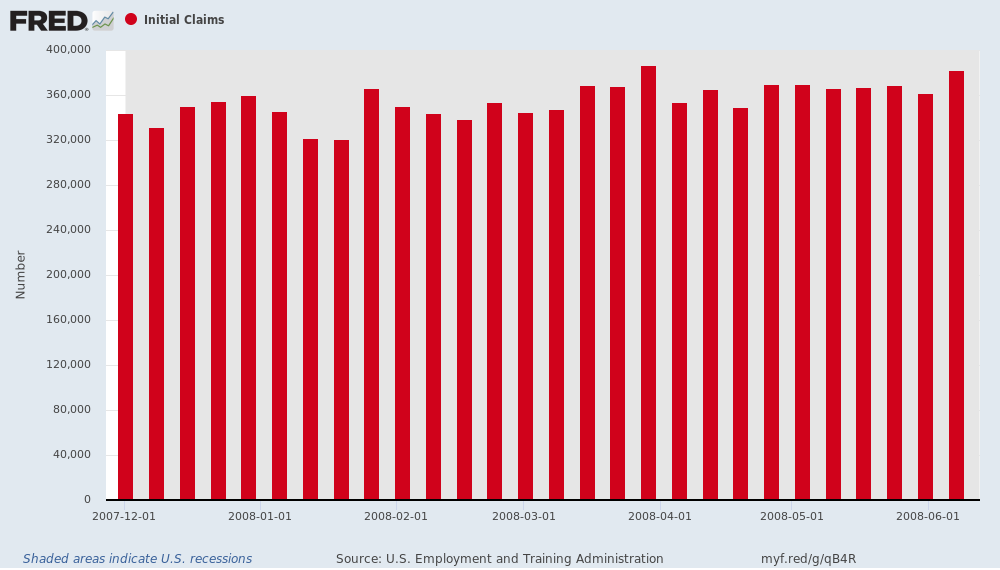
Indeed, the thinly disguised subtext in the whole daily MSM narrative for the last couple of days has been that the benighted governors of the Red States are not doing their part to order their economies into instant cardiac arrest. But it took the perennially obnoxious liberal columnist for the New York Times, David Leonhardt, to come right out and say it.
How bad will Canada’s COVID-19 recession be?
How bad will Canada’s COVID-19 recession be?
2 million jobs could be at stake, and the economy could shrink by more than it did in 2009

The black swan has landed.
The novel coronavirus pandemic is well underway worldwide, but it wasn’t until this month that Canadians started coming to grips with the economic pain it can bring, in addition to its heavy human toll.
Economists are struggling to come up with best guesses as to what might be coming. There’s still a lot that they — and we — don’t know. But the picture they’re painting for Canada’s financial future is already bleak.
GDP could significantly contract
At a minimum, the Conference Board of Canada is assuming that most industries across the country will be essentially shut down for at least six weeks.
If they take an optimistic view and assume that’s enough to contain the outbreak, even that short term pain will make a major dent in the country’s total output, a metric known as the Gross Domestic Product, or GDP.
Should this relatively mild scenario come to pass, Canada’s economy would eke out a tiny 0.3 per cent growth for 2020 as a whole as things ramp up in the latter half of the year. That’s far from booming — Canada’s economy grew by 1.6 per cent last year, for example — but it’s preferable to other alternatives.

…click on the above link to read the rest of the article…
Will The Corona Virus Trigger A Recession?
Will The Corona Virus Trigger A Recession?
As if waking up to an economic nightmare, investors see headlines like these and many others flashing across their Bloomberg terminals:
- Facebook says Oculus headphone production will be delayed due to virus
- Apple extends country wide store closing for another week
- Foxconn delays iPhone production
- Qualcomm cuts production forecast due to virus uncertainty
- Starbucks announces China store closures through Lunar New Year, uncertain when they may reopen
- US Steel flashes a warning of a cut in demand
- Nike shoe production halted
- Under Armour missed on sales, and their outlook is weak. They partially blamed the Corona Virus outbreak.
- IEA forecasts drop in oil demand this quarter- first time in a decade
The seemingly never ending list of delays, disruptions, and cuts rolls on from retail to high technology. Even services are impacted as flights and train trips are canceled within and to and from China. While some technology-based services are provided over the Internet service, restaurants, training, and consulting, as examples, must be performed in person. Manufacturing operations require workers to be at the factory to produce products. Thus, manufacturing is much more acutely affected by quarantines, shutdowns, transportation disruption, and other government actions.
It is as if an economic tsunami is rolling over the global economy. China’s economy was 18 % of world GDP in 2019. For most S & P 100 corporations, the Asian giant is their fastest growing market at 20 – 30 % per year. Even more critical, China has become the hub of world manufacturing after entering the World Trade Organization in 2000. Over the past two decades, U.S. corporations have relocated manufacturing to China to leverage an inexpensive labor force and modern business infrastructure.

Source: The Wall Street Journal – 2/7/20
Prior to the epidemic, world trade had begun to slow as a result of the China – U.S. trade war and other tariffs. World trade for the first time since the last recession has turned negative.

It Is Easy to Overreact to the Chinese Coronavirus
It Is Easy to Overreact to the Chinese Coronavirus
Recently, a new coronavirus has been causing many illnesses and deaths. The virus first became active in Wuhan, China, but it has already spread to the rest of China. Scattered cases have been identified around the rest of the world as well.
There are two important questions that are already being encountered:
- How much of an attempt should be made to limit the spread of the new virus? For example, should businesses close to prevent the spread of the virus?
- Should this disease be publicized as being far worse than flu viruses that circulate each year and cause many deaths among the elderly and people in poor health? The median age of those dying from the new coronavirus seems to be about 75.
Unfortunately, there aren’t easy answers. We can easily see the likely outcome of under reaction. More people might die of the disease. More people might find themselves out of work for a couple of weeks or more with the illness. We tend to be especially concerned about ourselves and our own relatives.
The thing that is harder to see is that reacting too vigorously can have a hugely detrimental impact on the world economy. The world economy depends on international trade and tourism. China plays a key role in the world economy. Quarantines of whole regions that last for weeks and months can have a very detrimental impact on the wages of people in the area and profits of local companies. Problems with debt can be expected to spike. The greater the reaction to the coronavirus, the more likely the world economy will be pushed toward recession and job loss.
…click on the above link to read the rest of the article…
“Last Hurrah” for Central Bankers
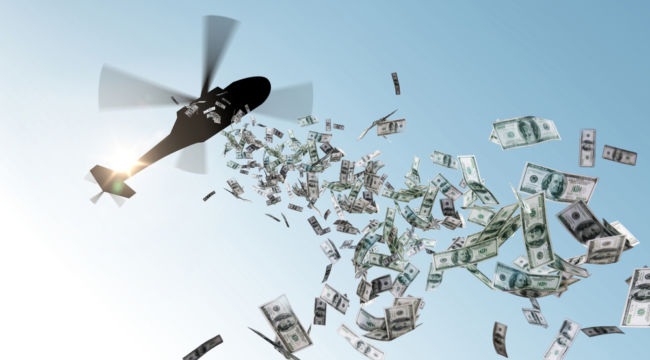
“Last Hurrah” for Central Bankers
We’ve all seen zombie movies where the good guys shoot the zombies but the zombies just keep coming because… they’re zombies!
Market observers can’t be blamed for feeling the same way about former Fed Chair Ben Bernanke.
Bernanke was Fed chair from 2006–2014 before handing over the gavel to Janet Yellen. After his term, Bernanke did not return to academia (he had been a professor at Princeton) but became affiliated with the center-left Brookings Institution in Washington, D.C.
Bernanke is proof that Washington has a strange pull on people. They come from all over, but most of them never leave. It gets more like Imperial Rome every day.
But just when we thought that Bernanke might be buried in the D.C. swamp, never to be heard from again… like a zombie, he’s baaack!
Bernanke gave a high-profile address to the American Economic Association at a meeting in San Diego on Jan. 4. In his address, Bernanke said the Fed has plenty of tools to fight a new recession.
He included quantitative easing (QE), negative interest rates and forward guidance among the tools in the toolkit. He estimates that combined, they’re equal to three percentage points of additional rate cuts. But that’s nonsense.
Here’s the actual record…
That QE2 and QE3 did not stimulate the economy at all; this has been the weakest economic expansion in U.S. history. All QE did was create asset bubbles in stocks, bonds and real estate that have yet to deflate (if we’re lucky) or crash (if we’re not).
Meanwhile, negative interest rates do not encourage people to spend as Bernanke expects. Instead, people save more to make up for what the bank is confiscating as “negative” interest. That hurts growth and pushes the Fed even further away from its inflation target.
What about “forward guidance?”
…click on the above link to read the rest of the article…
Expect low oil prices in 2020; tendency toward recession
Expect low oil prices in 2020; tendency toward recession
Energy Forecast for 2020
Overall, I expect that oil and other commodity prices will remain low in 2020. These low oil prices will adversely affect oil production and several other parts of the economy. As a result, a strong tendency toward recession can be expected. The extent of recessionary influences will vary from country to country. Financial factors, not discussed in these forecasts, are likely also to play a role.
The following are pieces of my energy forecast for 2020:
[1] Oil prices can be expected to remain generally low in 2020. There may be an occasional spike to $80 or $90 per barrel, but average prices in 2020 are likely to be at or below the 2019 level.

Figure 1. Average annual inflation-adjusted Brent equivalent oil prices in 2018 US$. 2018 and prior are as shown in BP’s 2019 Statistical Review of World Energy. Value for 2019 estimated by author based on EIA Brent daily oil prices and 2% expected inflation.
Figure 2 shows in more detail how peaks in oil prices have been falling since 2008. While it doesn’t include early January 2020 oil prices, even these prices would be below the dotted line.

Figure 2. Inflation adjusted weekly average Brent Oil price, based on EIA oil spot prices and US CPI-urban inflation.
Oil prices can temporarily spike because of inadequate supply or fear of war. However, to keep oil prices up, there needs to be an increase in “demand” for finished goods and services made with commodities. Workers need to be able to afford to purchase more goods such as new homes, cars, and cell phones. Governments need to be able to afford to purchase new goods such as paved roads and school buildings.
…click on the above link to read the rest of the article…
Recession Ahead: An Overview of Our Predicament
Recession Ahead: An Overview of Our Predicament
Many people have the impression that recessions come from financial missteps, such as the US subprime loan fiasco. If energy is involved at all, the problem comes from high oil prices as supply becomes inadequate to meet demand.
The real situation is different. We already seem to be on the road toward a new crisis; this crisis is likely to be much worse than the Great Recession of 2008-2009. This time, a major problem is likely to be energy prices that are too low for producers. Last time, a major problem was oil prices that were too high for consumers. The problem is different, but it is in some ways symmetric.
Last time, the United States seemed to be the epicenter; this time, my analysis indicates China is likely to be the epicenter. Last time, the world economy was coming off a high growth period; this time, the world economy is already somewhat depressed, even before hitting headwinds. These differences, plus the strange physics-based way that the world economy is organized, explain why the outcome seems likely to be worse this time than in 2008-2009.
I recently explained what I see as happening in a presentation for actuaries: Recession Likely: Expect a Bend in Trend Lines. This post is based on this presentation, omitting the strictly insurance-related portions.
The big thing that the vast majority of people do not understand is how important energy is to the economy. Because of this issue, I started my presentation with this slide:

Slide 3
After an opportunity for discussion, I offered the explanation that the role of food for humans is very much parallel to the need for energy of various types for the world economy. Food provides people with the energy required if they are to have the ability to think, move and speak.
…click on the above link to read the rest of the article…
5 More Signs That The Global Economy Is Careening Toward A Recession
5 More Signs That The Global Economy Is Careening Toward A Recession
The global economy is already in the worst distress that we have seen since 2008, and it appears that the global slowdown is actually picking up pace as we head into 2020. And this is happening even though central banks around the world have been cutting interest rates and pumping massive amounts of money into their respective financial systems. The central bankers appear to be losing control, and it certainly wouldn’t take much of a push for this new crisis to evolve into a complete and utter nightmare. The U.S. economy hasn’t been hit quite as hard as economies in Asia and Europe have been, but without a doubt things are slowing down here too. Corporate earnings have been falling quarter after quarter, auto loan delinquencies just hit a record high, the Cass Freight Index has declined for 11 consecutive months, and we just witnessed the largest drop for U.S. industrial production since 2009. Everywhere around us there is bad economic news, but most Americans are still completely oblivious to what is happening.
In this article, I am going to share even more evidence that a global economic slowdown has already begun. When you add these numbers to all of the other numbers that I have been sharing in recent weeks, it becomes impossible to deny that something major is taking place.
The following are 5 more signs that the global economy is careening toward a recession…
#1 It is being projected that global auto sales will be down approximately 4 percent this year. According to CNN, this will be the second consecutive year that global auto sales have fallen…
…click on the above link to read the rest of the article…
Brace For Impact! The U.S. Economy Is Going Down, And It Is Going Down Hard…
Brace For Impact! The U.S. Economy Is Going Down, And It Is Going Down Hard…
I have so many bad economic numbers to share with you that I don’t even know where to start. I had anticipated that the U.S. economic slowdown would accelerate during the fourth quarter of 2019, and that is precisely what has happened. The Federal Reserve is trying to do all that it can to keep us from officially slipping into a recession, and the federal government is literally spending money as if tomorrow will never come, but all of that intervention has not been enough to reverse our economic momentum. We are really starting to see conditions begin to deteriorate very rapidly now, and 2020 is already shaping up to be the most pivotal year for the U.S. economy since 2008.
Let me start my analysis by discussing how U.S. consumers are doing right now. According to CBS News, a major new study that was just released found that 70 percent of all Americans are struggling financially…
Many Americans remain in precarious financial shape even as the economy continues to grow, with 7 of 10 saying they struggling with at least one aspect of financial stability, such as paying bills or saving money.
The findings come from a survey of more than 5,400 Americans from the Financial Health Network, a nonprofit financial services consultancy. The project, which started a year ago, is aimed at assessing people’s financial health by asking about debt, savings, bills and wages, among other issues.
That sure doesn’t sound like a “booming economy”, does it?
And even though things are already really tough for millions upon millions of American families, it appears that things are rapidly getting worse. In fact, we just witnessed the largest decline for the Bloomberg Consumer Comfort Index since 2008…
…click on the above link to read the rest of the article…
GDP Estimates Crash on Dismal Economic Reports
GDP Estimates Crash on Dismal Economic Reports

GDP Estimates are well below 1.0% following industrial production and retail sales estimates.
The GDPNow model forecast for the fourth quarter took a dive today to 0.3% from 1.0% a week ago. Similarly, the Nowcast model fell to 0.4% from 0.7%.
Pat Higgins at GDPNow explains:
“The GDPNow model estimate for real GDP growth (seasonally adjusted annual rate) in the fourth quarter of 2019 is 0.3 percent on November 15, down from 1.0 percent on November 8. After this morning’s retail trade releases from the U.S. Census Bureau, and this morning’s industrial production report from the Federal Reserve Board of Governors, the nowcasts of fourth-quarter real personal consumption expenditures growth and fourth-quarter real gross private domestic investment growth decreased from 2.1 percent and -2.3 percent, respectively, to 1.7 percent and -4.4 percent, respectively.”
Real gross private domestic development is now clocking at -4.4%.
Wow.
Recession Warnings
A bit ago I noted Industrial Production Dives and It’s Not All Strike Related.
Trucking provide another recession warning: Freight Volumes Negative YoY for 11th Straight Month
Donald Broughton, founder of Broughton Capital and author the Cass Freight Index says the index signals contraction, possibly by the end of the year. That’s just one one month away.
Strike Resolved
The GM strike is resolved. We will soon find out how much strike-related damage there was, but the risk is over-estimating the rebound going forward.
The trade deal with China is still unresolved.
What Heavy Trucks Are Saying
What Heavy Trucks Are Saying
“I do believe that in North America it is a cyclical downturn”: Cummins COO.
Orders for heavy trucks, after the historic boom in 2018, plunged this year, but they may have finally bottomed out. In October 2019, truck makers in the US received about 22,072 orders for Class-8 trucks, according to preliminary estimates by FTR Transportation Intelligence. While up by about 10,000 orders from the dismal levels in September, and the highest number so far this year, orders were still down 51% from October last year ago, “signifying a subdued beginning to the traditional start of the ordering season,” FTR said:
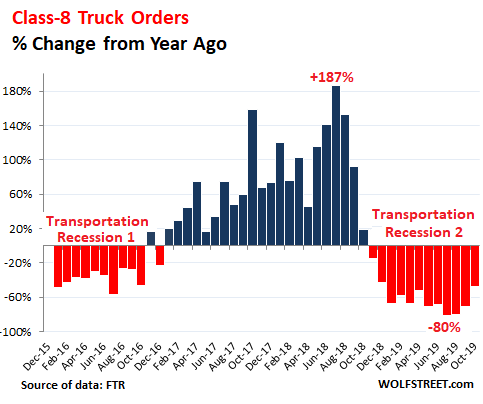
“The order level was boosted by a couple of big fleets placing large orders into 2020, but otherwise smaller orders were placed for the first quarter build,” FTR said in a statement. “Cancellations are expected to remain elevated as OEM’s shake out excess 2019 orders from the backlog.”
These OEMs are Freightliner, the largest truck maker in the US, and Western Star, both divisions of Daimler; Peterbilt and Kenworth, divisions of Paccar [PCAR]; Navistar International [NAV]; and Mack Trucks and Volvo Trucks, divisions of Volvo Group.
The historic boom of Class-8 truck orders that started in late 2017 and roared through most of 2018 was a result of a series of events triggered by all kinds of companies trying to front-run potential tariffs. Companies ordered excessively to dodge the tariffs, and they filled their warehouses, and it triggered a shipment boom. To meet this demand, trucking companies responded by ordering a historic number of trucks.
But this boom began to unwind in late 2018, and then turned into a collapse of orders that lasted through September 2019 when it appeared to have hit bottom. October looked better. But October 2016 looked better too, only to be followed by a very tough year. Orders in October 2019 were the lowest for any October since 2016:
…click on the above link to read the rest of the article…
November 4th, 2019… Back in the Real World…
November 4th, 2019… Back in the Real World…
Trawling through the market headlines this morning, I’m struck by the number of comments about how much better the investment environment looks. There is less likelihood of a global recession, corporate earnings aren’t as bad as expected, and jobs are growing. I am unconvinced. I see worrying connections across the wires. From my perspective – which admittedly has been from a train in the middle of nowhere – its feels we’ve reached the end of the something. Time has been called on this particular era of irrational market exhuberance.
My spidey senses are tingling due to manner in which events across markets, individual stocks, politics, geopolitics and gut-instinct are connected. I’m not predicting sudden or massive financial collapse – just a wake up and smell the coffee correction in Bonds (which feels underway), and selective deflation in over-optimistic sectors of the stock markets. As always, any reversal will set off wailing and despair, yet most of the critical lessons will be missed. Fear not – we will get another chance to relearn them in a few years time! (Blain’s Market Mantra No 2: The Market has no memory.)
It’s just as well we aren’t heading for the deep prolonged global recession so many naysayers have been predicting thru 2019. Slowdown yes. Trade is going to remain a problem. But growth drivers were changing anyway. Tech will change the world’s trade roads. China’s furious growth spurt of the last 20 years is over. India might be growing, but it lacks the state momentum to drive global growth the way China did. And climate change will prove deeply significant in the future as consumers are persuaded to believe food miles and imports matter.
…click on the above link to read the rest of the article…
The Allure and Limits of Monetized Fiscal Deficits
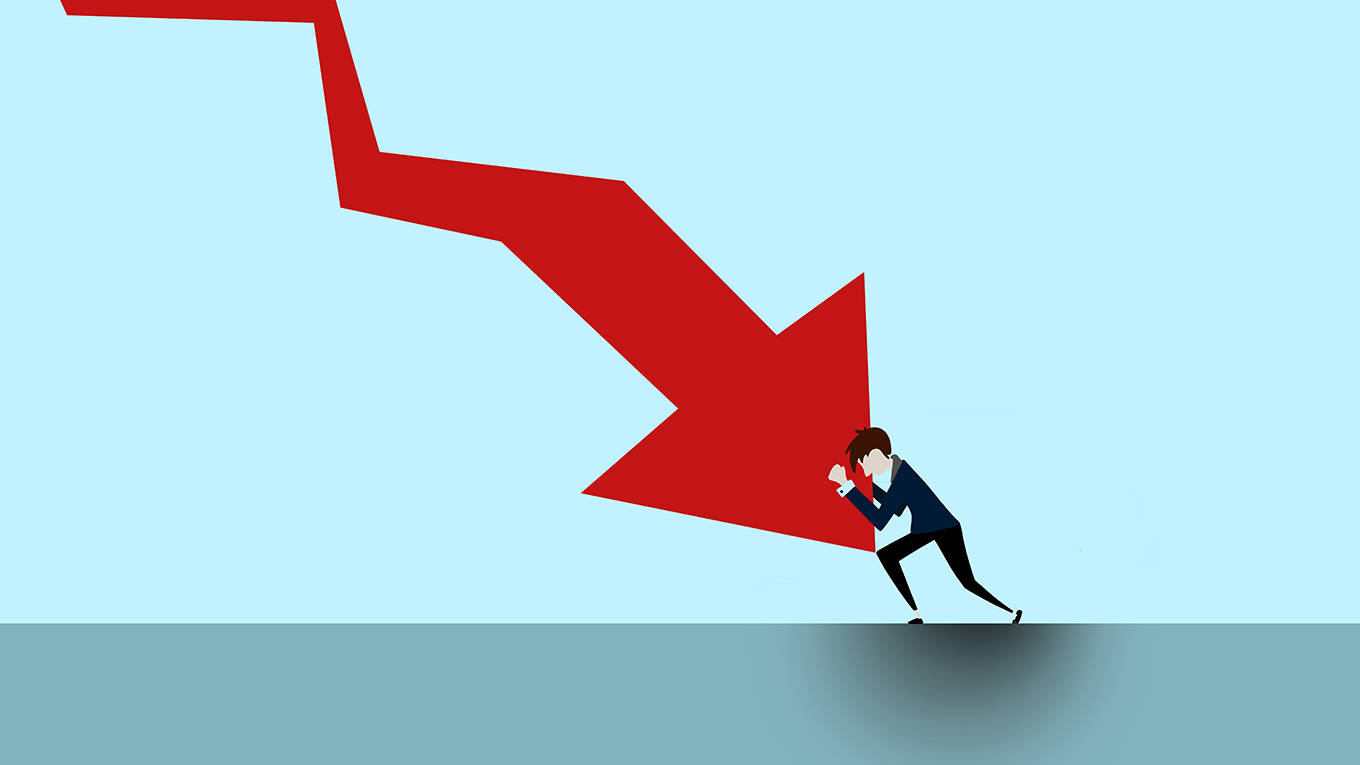
The Allure and Limits of Monetized Fiscal Deficits
With the global economy experiencing a synchronized slowdown, any number of tail risks could bring on an outright recession. When that happens, policymakers will almost certainly pursue some form of central-bank-financed stimulus, regardless of whether the situation calls for it.
NEW YORK – A cloud of gloom hovered over the International Monetary Fund’s annual meeting this month. With the global economy experiencing a synchronized slowdown, any number of tail risks could bring on an outright recession. Among other things, investors and economic policymakers must worry about a renewed escalation in the Sino-American trade and technology war. A military conflict between the United States and Iran would be felt globally. The same could be true of “hard” Brexit by the United Kingdom or a collision between the IMF and Argentina’s incoming Peronist government.
Still, some of these risks could become less likely over time. The US and China have reached a tentative agreement on a “phase one” partial trade deal, and the US has suspended tariffs that were due to come into effect on October 15. If the negotiations continue, damaging tariffs on Chinese consumer goods scheduled for December 15 could also be postponed or suspended. The US has also so far refrained from responding directly to Iran’s alleged downing of a US drone and attack on Saudi oil facilities in recent months. US President Donald Trump doubtless is aware that a spike in oil prices stemming from a military conflict would seriously damage his re-election prospects next November.
The United Kingdom and the European Union have reached a tentative agreement for a “soft” Brexit, and the UK Parliament has taken steps at least to prevent a no-deal departure from the EU. But the saga will continue, most likely with another extension of the Brexit deadline and a general election at some point.
…click on the above link to read the rest of the article…
Federal Reserve Chair Jerome Powell Insists There Won’t Be A Recession When All The Evidence Suggests Otherwise
Federal Reserve Chair Jerome Powell Insists There Won’t Be A Recession When All The Evidence Suggests Otherwise
It’s happening again. Just like last time around, the head of the Federal Reserve is telling us that there won’t be a recession even though all of the evidence suggests otherwise. Just before the recession of 2008, Federal Reserve Chair Ben Bernanke told the country that “the Federal Reserve is not currently forecasting a recession”, and shortly thereafter we plunged into the worst economic downturn since the Great Depression of the 1930s. This time, it is Federal Reserve Chair Jerome Powell that is attempting to prop things up by making positive statements that are not backed up by reality. Speaking to a group at the University of Zurich, Powell insisted that the Fed is “not at all” anticipating that there will be a recession…
Federal Reserve Chairman Jerome Powell said Friday that he doesn’t “at all” expect the U.S. to enter a recession, though he hinted the central bank will likely cut interest rates as expected this month.
“Our main expectation is not at all that there will be a recession,” Powell said in a panel discussion at the University of Zurich.
Meanwhile, things are literally falling apart all around us. Just a few days ago, I put together a list of 28 data points that clearly indicate that a recession is imminent, and since then we have gotten even more bad news.
For instance, we just learned that Fred’s will be filing for bankruptcy and closing more than 500 stores…
Discount merchandise retailer and pharmacy chain Fred’s filed for Chapter 11 bankruptcy Monday with plans to close all of its stores.
The company plans to liquidate its assets, punctuating a swift collapse of its operations that involved a cascading series of store closures in recent months.
…click on the above link to read the rest of the article…
Sluggish Oil Demand To Keep A Lid On Oil Prices Amid Global Recession Fears
Sluggish Oil Demand To Keep A Lid On Oil Prices Amid Global Recession Fears
John Kemp, senior market analyst of commodities at Reuters, cites a new report via B.P.’s finance chief that indicates global oil consumption will be less than 1 million barrels per day this year, an ominous sign that the global economy is quickly deteriorating.
Kemp said growth is expected to be less than one million barrels per day (bpd) would represent an increase of less than 1% in global oil consumption and the lowest level of growth since 2014 and before that 2012.
Back then, declining demand was due to elevated oil prices averaging above $100 per barrel in real terms. Now prices trend in the $50-$60 range for WTI, confirming that even with low oil prices, demand is nowhere to be seen.
B.P.’s global oil consumption is the most bearish among other predictions from the International Energy Agency (+1.1 million bpd), OPEC (+1.1 million) and the U.S. Energy Information Administration (+1.0 million).
Waning demand for oil across the world is the result of a global manufacturing recession festering underneath the surface. The global synchronized decline is structural and started in 4Q17, several months later, the trade war between the U.S. and China erupted in 1Q18.
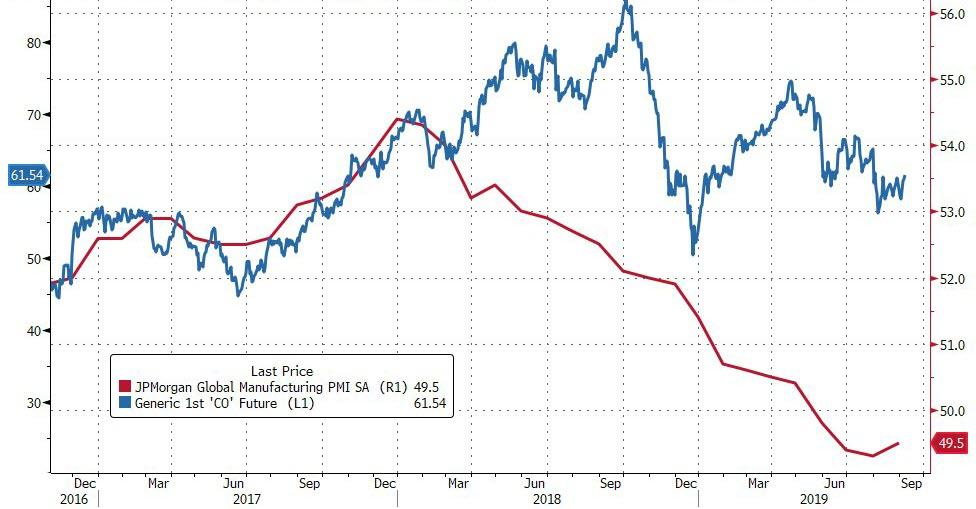
Since global GDP drives oil consumption. Kemp shows that the World Bank (“Global economic prospects,” June 2019) data is indicating world growth will be in a slump this year. Estimates show global GDP has been revised lower from 3.0% in 2018 to just 2.6% in 2019.
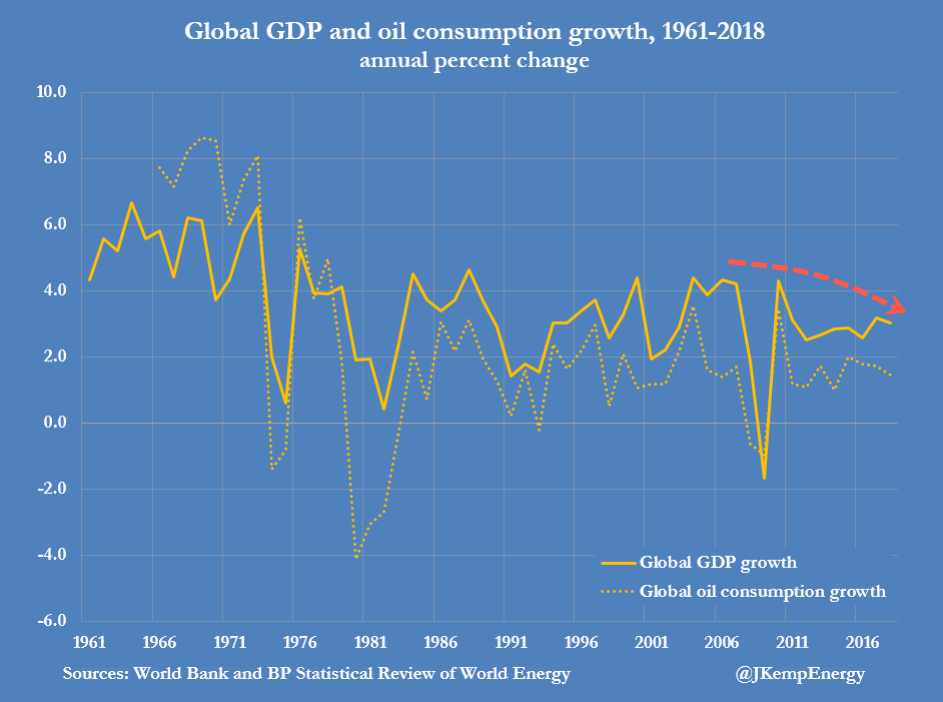
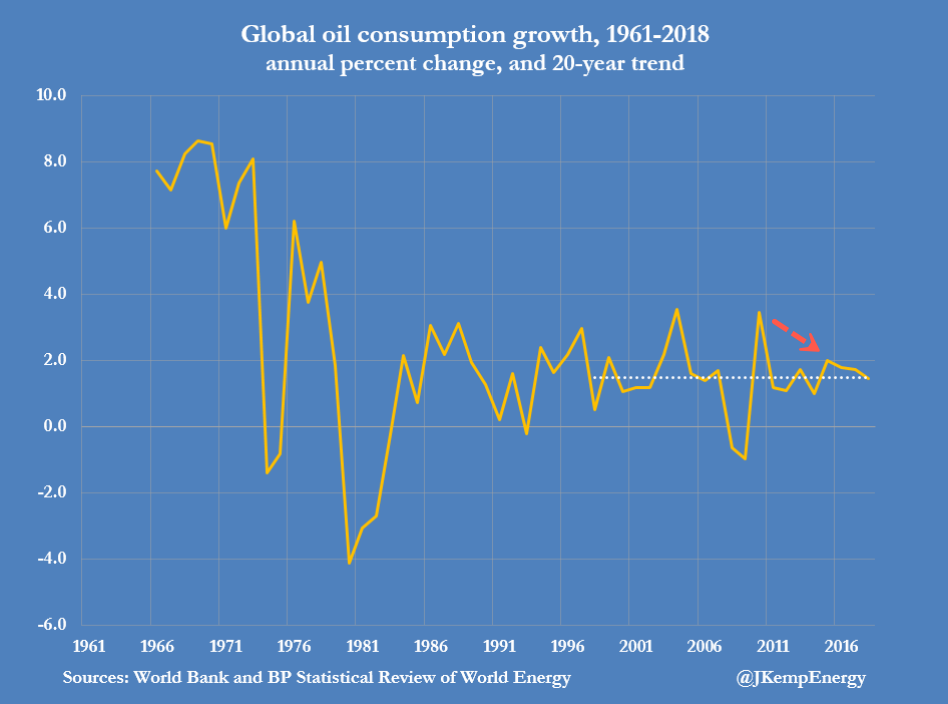
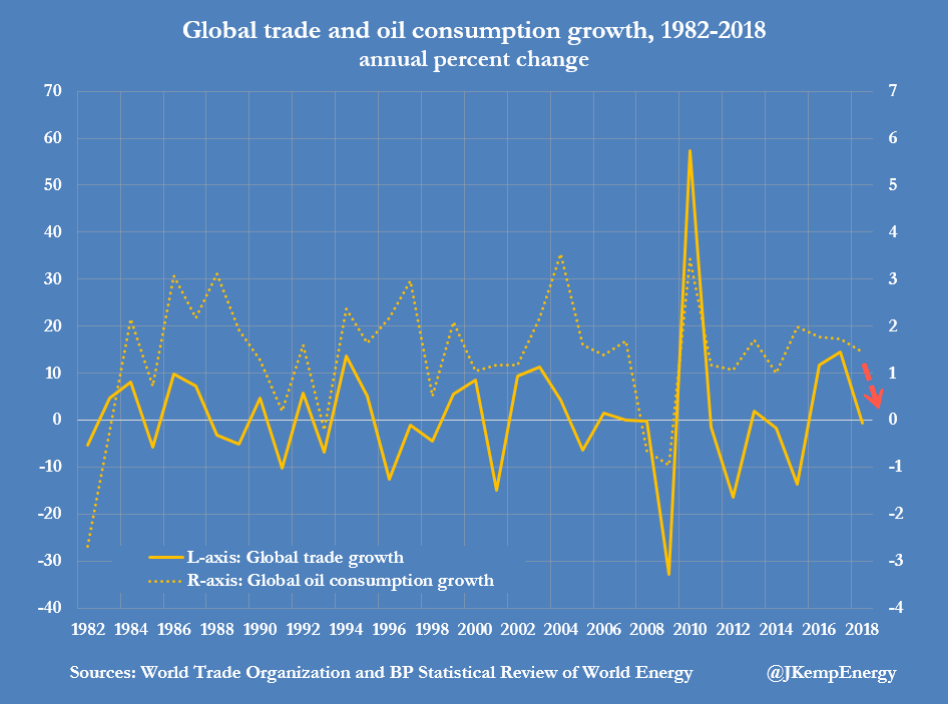
Global GDP growth is at the same level as 2014 and before that 2012. So it makes sense why oil consumption has dropped to a five year low, it’s because the global economy has lost tremendous amounts of momentum, now reversing into a vicious downturn.
…click on the above link to read the rest of the article…





